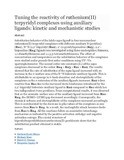| dc.contributor.author | Mutua, Gershom Kyalo | |
| dc.contributor.author | Sitati, Meshack | |
| dc.contributor.author | Onunga, Daniel O. | |
| dc.contributor.author | Jaganyi, Deogratius | |
| dc.contributor.author | Mambanda, Allen | |
| dc.contributor.author | Mechanisms and Catalysis | |
| dc.date.accessioned | 2022-09-19T12:02:32Z | |
| dc.date.available | 2022-09-19T12:02:32Z | |
| dc.date.issued | 2022-07-22 | |
| dc.identifier.uri | https://doi.org/10.1007/s11144-022-02272-0 | |
| dc.identifier.uri | http://ir-library.mmust.ac.ke:8080/xmlui/handle/123456789/2099 | |
| dc.description.abstract | Substitution behavior of the labile aqua ligand in four mononuclear ruthenium(II) terpyridyl complexes with different auxiliary N (pyridine) (Ru1), N^N (2,2′-bipyridyl (Ru2), 2′-(2-pyridyl)quinoline (Ru3), 2,2′-biqunoline (Ru4) ligands was investigated using three nucleophiles; thiourea, 1,1-dimethylthiourea and 1,1,3,3-tetramethylthiourea. The effect of concentration and temperature on the substitution behavior of the complexes were studied under pseudo-first order conditions using UV–Vis spectrophotometer. The second order rate constants (k2) of the aqua complexes decreased in the order: Ru4 > Ru3 > Ru1 > Ru2. The results showed that the rate of substitution of the aqua ligand increased with an increase in the π-surface area of the N^N bidentate auxiliary ligands. This is attributable to an upsurge in π-back-donation and electrophilicity of the complexes as the π-extension of the auxiliary ligands increases. Ru2 is less reactive than Ru1 due to the increased steric hinderance introduced by the 2,2′-bipyridyl bidentate auxiliary ligand in Ru2 compared to Ru1 which has two independent trans pyridines. From computational results, it was observed that as the aromatic surface area of the auxiliary ligand increased from Ru1–Ru4, the HOMO–LUMO gap decreased accordingly. Consequently, the chemical softness and electrophilicity of the complexes increased accordingly. This is corroborated by the decrease in pKa values of the complexes as one moves from Ru1 to Ru4. As a result, the nucleophilic attack becomes facile from Ru1 to Ru4. All the reactions follow an associative interchange mechanism as indicated by the positive activation enthalpy and negative activation entropy. The crystal structure of bipyridylterpyridylthiourearuthenium(II) perchlorate show that the substitution product obtained is stable. | en_US |
| dc.language.iso | en | en_US |
| dc.publisher | Reaction Kinetics, Mechanisms and Catalysis | en_US |
| dc.subject | Tuning , reactivity, ruthenium(II), terpyridyl, complexes, auxiliary, ligands, kinetic, mechanistic, studies | en_US |
| dc.title | Tuning the reactivity of ruthenium(II) terpyridyl complexes using auxiliary ligands: kinetic and mechanistic studies | en_US |
| dc.type | Article | en_US |

